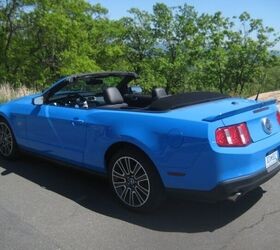The 2010 Ford Mustang GT arrived on the scene as more than just a facelift; it was an evolution of the iconic pony car, building upon the SN197 chassis while aiming to refine the formula. For enthusiasts and potential buyers in the market for a blend of classic American muscle and modern driving dynamics, the 2010 Mustang Gt presented a compelling, if not entirely perfect, proposition. This review delves into the details of the 2010 Mustang GT, examining its styling, interior, performance, and overall driving experience to provide a comprehensive understanding of what this model year offers.
The spirit of the original Ford Mustang, conceived by Lee Iacocca, was rooted in affordability and style, appealing to a burgeoning generation. Fast forward to 2010, and the Mustang found itself in a different landscape. While the core appeal of bold styling and V8 power remained, expectations had risen, and the competition had intensified. The 2005 redesign marked a significant step forward, shifting perceptions from a simple Falcon-based coupe to a more serious contender. However, the 2010 model sought to address lingering criticisms and further elevate the Mustang experience.
Visually, the 2010 Mustang GT underwent a noticeable refresh. Ford aimed for a more aggressive and contemporary look while staying true to the Mustang’s heritage. The front fascia adopted sharper lines, with redesigned headlights and a more pronounced grille, giving the car a more menacing stare. The power dome hood hinted at the potent V8 lurking beneath, and the sculpted fenders added to the muscular stance. While opinions on styling are subjective, the 2010 Mustang GT’s aesthetics generally resonated well, blending retro cues with a modern edge. The rear also received attention with sequential LED taillights, a nod to classic Mustangs, further enhancing the visual appeal. Paint options like Red Candy Metallic, often paired with saddle interiors and stylish alloy wheels, amplified the car’s curb appeal, making it a head-turner on the road.
Stepping inside the 2010 Mustang GT, the interior aimed for a blend of retro design and enhanced functionality, though with some compromises. The instrument cluster featured gauges with a classic font, evoking Mustangs of the past. However, some found the readouts a bit challenging to decipher at a glance. The center console saw revisions, including updated cup holders, now with a flip-up cover for a cleaner look when not in use. One notable point of contention was the automatic transmission shifter. Its increased height and bulkier design could obstruct access to the climate controls, a minor ergonomic drawback. Manual transmission models sidestepped this issue, and thankfully, the center storage bin was redesigned with an integrated lid, addressing a previous complaint about the elbow-bumping binnacle. However, the storage space itself was somewhat awkwardly shaped and potentially smaller than before, a practical consideration in a car not renowned for its abundant interior storage.
Under the hood, the heart of the 2010 Mustang GT remained the venerable 4.6-liter V8 engine, a staple of Mustang performance. While it carried over from previous years, it still delivered a respectable 315 horsepower and ample torque, providing the Mustang GT with its signature muscle car grunt. Power was delivered to the rear wheels via either a 5-speed manual or a 5-speed automatic transmission (5R55S). The automatic, while offering reasonably quick shifts, was arguably less engaging than the manual for driving enthusiasts. Acceleration, while certainly capable of tire-chirping launches, might not have felt as explosive as some expected, especially compared to later iterations of the Mustang GT. This could be attributed to factors like the standard 3.31:1 rear axle ratio, which prioritized cruising over outright acceleration. Optional 3.55 and 3.73 ratios were available for those seeking quicker off-the-line performance. The engine note, enhanced by an engine-noise tube, provided a satisfying V8 soundtrack, contributing to the overall driving experience.
Beyond straight-line speed, the 2010 Mustang GT showcased improvements in handling. While still equipped with a solid rear axle, a characteristic of Mustangs for decades, the chassis demonstrated a balanced feel for its class. Enthusiasts seeking ultimate track performance might find it lacking compared to more sophisticated independent rear suspension setups, but for spirited road driving, the 2010 Mustang GT delivered a competent and enjoyable experience. Steering feedback was noticeably improved compared to earlier models, providing more confidence in corners. The tires offered good grip, and the chassis felt relatively composed during spirited driving, inspiring confidence on twisty roads. Furthermore, the ride quality was refined, offering a smoother and quieter experience than previous Mustangs, making it more comfortable for daily driving. However, it remained advisable to approach potholes with caution, ensuring both rear wheels hit them simultaneously to maintain composure.
In the competitive landscape, the 2010 Ford Mustang GT occupied a unique position. It aimed to bridge the gap between affordable muscle and more refined sports cars. While it offered a significant step up from previous Mustangs in terms of handling, interior quality, and overall sophistication, it still faced stiff competition from European and Japanese rivals like the Audi A4 and BMW 3-Series convertibles in terms of outright refinement and technology. However, the Mustang GT held a distinct advantage in terms of price and iconic American muscle car appeal. For buyers prioritizing V8 power, classic styling, and a visceral driving experience at a more accessible price point, the 2010 Mustang GT presented a compelling choice. It represented the best of the breed up to that point, even if it still carried some inherent compromises compared to higher-priced competitors. Ultimately, the 2010 Ford Mustang GT successfully leveraged nostalgia and the enduring appeal of the Mustang nameplate, offering a blend of performance and style that resonated with a broad audience.
